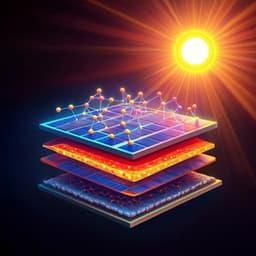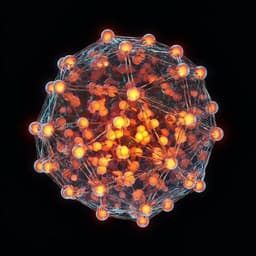
Engineering and Technology
Constructing molecular bridge for high-efficiency and stable perovskite solar cells based on P3HT
D. Xu, Z. Gong, et al.
Discover how a novel molecular bridge, MDN, enhances the performance of P3HT in perovskite solar cells, boosting power conversion efficiency to 22.87% and improving long-term stability. This groundbreaking research was conducted by Dongdong Xu, Zhiming Gong, Yue Jiang, Yancong Feng, Zhen Wang, Xingsen Gao, Xubing Lu, Guofu Zhou, Jun-Ming Liu, and Jinwei Gao.
~3 min • Beginner • English
Introduction
Organic–inorganic hybrid perovskite solar cells (PSCs) are promising for low-cost, high-efficiency photovoltaics, yet stability and interfacial losses remain key barriers. Typical n–i–p PSCs require a hole transport material (HTM) that efficiently extracts and transports holes while protecting the perovskite from moisture. Doped Spiro-OMeTAD is widely used but suffers from instability due to hygroscopic, mobile dopants that can corrode perovskites and migrate, hindering long-term stability and commercialization. Dopant-free HTMs have been explored, including various small molecules and polymers, reporting high PCEs but often with complex syntheses, higher cost, and limited reproducibility, and not replacing doped Spiro-OMeTAD in practice. P3HT is an attractive, mature, low-cost p-type semiconductor HTM, but its edge-on stacking leads to poor electronic contact with perovskite (alkyl chains at the interface), exacerbating interfacial non-radiative recombination and limiting PCE (~16%). Prior interfacial strategies (e.g., passivation layers, packing modulation, and dopants) improved P3HT-based device performance, but the fundamental poor contact at the perovskite/P3HT interface is insufficiently addressed. This work introduces a molecular bridge (MDN) designed to anchor to perovskite and π–π stack with P3HT to build an efficient interfacial charge-transport channel and concurrently passivate defects, aiming to enhance PCE, reduce hysteresis and recombination, and improve stability.
Literature Review
The paper reviews limitations of doped Spiro-OMeTAD (instability from hygroscopic, mobile dopants causing perovskite corrosion and migration) and efforts toward dopant-free HTMs, including small molecules (e.g., DTP-C6Th, YZ22, DTB-FL, NiPc) and polymers (e.g., 2DP-TDB, PC6, Mes-TABT). Despite reported PCEs exceeding 21%, issues of synthetic complexity, cost, and performance reproducibility limit their practical adoption. For P3HT HTMs, poor interfacial contact due to edge-on packing induces recombination losses and limits PCE to ~16%. Interfacial engineering has included surface passivation (e.g., BTCIC-4CPP, CuSCN), molecular interlayers (HTAB) to modulate packing, and dopants (Ga(acac)3) to reduce recombination, with PCEs reported over 22–24%. Mobility enhancement via packing conversion to face-on has also been demonstrated. However, a targeted solution to the poor perovskite/P3HT electronic contact remains needed, motivating the molecular-bridge approach.
Methodology
- Molecule design and synthesis: Designed MDN (di-cyanovinyl end-group and triphenylamine-phenoxazine core) as a D–D–A small molecule to anchor perovskite via malononitrile and π–π stack with P3HT; RDN synthesized as a polarity-matched control. Synthetic routes provided in Supplementary Information.
- Materials and HTM preparation: MDN (4 mg) or RDN (4 mg) added to P3HT (10 mg mL−1 in chlorobenzene) to make M-P3HT and R-P3HT; other MDN loadings (2 mg, 6 mg per 10 mg P3HT) explored. Additional controls PDN and TDN also prepared and blended with P3HT. Solutions stirred at 60 °C for solubility.
- Film and structural characterization: GIWAXS on P3HT, M-P3HT, R-P3HT films (on Si and on perovskite) to assess packing. UV–vis absorption, ultraviolet photoelectron spectroscopy for optical/electronic levels. Conductivity measurements. Hole mobility by space-charge-limited current (SCLC) using hole-only devices (ITO/PEDOT:PSS/HTM/Ag).
- Device fabrication: Planar n–i–p architecture FTO/SnO2/Cs0.05FA0.85MA0.10Pb(Br0.03I0.97)3/HTM/Ag. SnO2 spin-coated and annealed at 150 °C. Perovskite precursor (DMF/DMSO solvent; antisolvent chlorobenzene) spin-coated (1000 rpm 10 s; 5000 rpm 30 s) and annealed at 150 °C ~10 min. HTM layer spin-coated (3000 rpm, 20 s). Ag top electrode (~100 nm) thermally evaporated. Active area 0.07 cm2 via aperture mask. Typical layer thicknesses: FTO 560 nm, SnO2 20 nm, perovskite 610 nm, HTM 30 nm, Ag 100 nm.
- Photovoltaic characterization: J–V under AM 1.5G (100 mW cm−2), forward/reverse scans and hysteresis index; EQE and integrated Jsc; steady-state power output at MPP; MPP light-soaking stability in N2 glovebox.
- Interfacial and charge dynamics: XPS (Pb 4f, I 3d, N 1s) to probe interfacial bonding and defect suppression; steady-state PL and time-resolved PL (excitation from perovskite side) for charge extraction and trap states; polystyrene (PS) tunneling interlayer tests to assess necessity of direct electronic coupling; electrical impedance spectroscopy (Nyquist plots for transfer/recombination resistances; capacitance-frequency behavior); dark J–V for leakage and saturation current density; VOC vs light intensity for recombination analysis.
- Computational: DFT (VASP, PBE-GGA, PAW) on FA0.875MA0.125PbI3 slabs (2×2×1, 20 Å vacuum, k-mesh 2×1×2, cutoff 400 eV) with MDN/RDN anchoring PbI3-terminated surfaces, with and without I vacancies (VI). Charge density difference and binding energies (ΔE). Molecular π–π interactions between MDN and P3HT assessed via Gaussian (B3LYP-D3(BJ)/6-311G**), IGMH and LOL analyses using Multiwfn and VMD.
- Environmental stability tests: Unencapsulated devices aged at 25 °C in ambient at 75% RH for 60 days then 85% RH for 30 days; morphology of aged films by SEM; water contact angle for hydrophobicity.
Key Findings
- MDN as a molecular bridge markedly improves P3HT-based PSCs: champion PCE 22.87% with M-P3HT vs 12.48% (P3HT) and 16.66% (R-P3HT). Corresponding device parameters: P3HT Voc 0.92 V, Jsc 23.21 mA cm−2, FF 58.73%; M-P3HT Voc 1.16 V, Jsc 24.58 mA cm−2, FF 80.17%; R-P3HT Voc 1.05 V, Jsc 23.90 mA cm−2, FF 66.54%.
- Reproducibility: Average PCEs over 20 devices: P3HT 10.73%, R-P3HT 15.33%, M-P3HT 21.19%. Steady-state MPP outputs: 10.31% (P3HT), 22.25% (M-P3HT), 14.76% (R-P3HT).
- Hysteresis strongly reduced with M-P3HT (hysteresis index ~2.6%) vs P3HT (~78.8%) and R-P3HT (~20.1%).
- Structural/transport properties: GIWAXS shows MDN/RDN do not alter P3HT edge-on packing; in-plane (010) qxy at 1.65 (P3HT), 1.62 (M-P3HT), 1.64 Å−1 (R-P3HT), corresponding π–π distances 3.81, 3.88, 3.83 Å. Hole mobilities (hole-only SCLC) ~3.03×10−3 cm2 V−1 s−1 (P3HT) and ~2.88×10−3 cm2 V−1 s−1 (M-P3HT/R-P3HT); similar conductivities across HTMs.
- XPS evidence of interfacial bonding and defect suppression with M-P3HT: Pb 4f and I 3d binding energies shift higher by ~560 and ~330 meV; metallic Pb0 signals suppressed. N 1s shows C=N peak shift (from 399.77 eV in MDN to 398.79 eV at perovskite/M-P3HT) and appearance of N-(Ph)3, consistent with malononitrile–Pb electrostatic coupling.
- Charge transfer and trap reduction: PL for M-P3HT shows higher intensity with blue-shift (799→792 nm), indicating lower trap density alongside extraction. TRPL average lifetimes: perovskite 1071.71 ns; with P3HT 464.75 ns; R-P3HT 397.38 ns; M-P3HT 302.37 ns, indicating fastest carrier transfer and reduced non-radiative recombination at perovskite/M-P3HT interface.
- Polystyrene tunneling interlayer test: inserting thin PS improves P3HT, has little effect on R-P3HT, but significantly reduces M-P3HT device performance (avg PCE 21.19%→18.35%), confirming the necessity of direct electronic coupling via the MDN bridge.
- DFT: Stronger binding for MDN to perovskite, especially with I vacancies: ΔE (PVK/MDN) −0.16 eV; (PVK-VI/MDN) −0.50 eV; (PVK/RDN) −0.02 eV; (PVK-VI/RDN) −0.08 eV. Charge density differences show greater charge transfer for MDN. IGMH/LOL analyses reveal pronounced π–π stacking between MDN (particularly its triphenylamine unit) and P3HT.
- Trap density (hole-only SCLC, Nt): P3HT 1.39×10^16 cm−3; M-P3HT 9.21×10^14 cm−3; R-P3HT 6.35×10^15 cm−3 (M-P3HT ~1/15 of P3HT), consistent with reduced non-radiative recombination. Hole mobilities (Child region) ~9.86×10−5 (P3HT), 4.10×10−5 (M-P3HT), 1.20×10−4 cm2 V−1 s−1 (R-P3HT).
- EIS: M-P3HT devices display lower transfer resistance (Rt) and higher recombination resistance (Rrec); capacitance decreased by ~2 orders at low frequency vs P3HT, indicating reduced interfacial charge accumulation.
- Recombination analysis: VOC vs light intensity slope smaller for M-P3HT (1.32 kT q−1) than R-P3HT (1.61) and P3HT (1.73), indicating suppressed recombination.
- Dark J–V: M-P3HT devices show lower leakage and lower saturation current density (reported J0 ≈ 9.7×10−7 mA cm−2) relative to P3HT (≈3.6×10−7 mA cm−2) and R-P3HT (≈1.5×10−5 mA cm−2), and higher current in high-voltage region (0.8–1.5 V), evidencing improved interfacial transport.
- Stability: Under continuous 1 sun MPP operation in N2, M-P3HT devices maintain nearly unchanged efficiency over >500 h. In ambient without encapsulation, at 75% RH for 60 days then 85% RH for 30 days (25 °C), M-P3HT retains ~92% of initial PCE; R-P3HT ~80%; P3HT drops to ~50% after 60 days at 75% RH. Aged morphology remains smooth/continuous for M-P3HT, unlike P3HT and R-P3HT. Enhanced stability attributed to hydrophobicity, tighter interfacial structure, and defect reduction.
Discussion
By engineering a molecular bridge (MDN) that simultaneously anchors to the perovskite surface (via malononitrile) and π–π stacks with P3HT (via the triphenylamine-containing conjugated core), the work directly addresses the poor electronic contact at the perovskite/P3HT interface. Interfacial electronic coupling and defect passivation are evidenced by XPS core-level shifts, suppression of metallic Pb0, PL/TRPL signatures of reduced trap-assisted recombination, and strong sensitivity to an insulating spacer layer. DFT corroborates stronger binding and charge transfer for MDN, especially at defect (I-vacancy) sites, and reveals effective π–π interactions with P3HT. These interfacial improvements translate to substantial gains in device metrics: higher Voc, Jsc, and FF; minimized hysteresis; lower trap density and recombination; and enhanced operational and environmental stability. The findings demonstrate that constructing a tailored molecular bridge is an effective strategy to unlock high-efficiency, stable PSCs using low-cost, commercially available P3HT HTM, highlighting relevance for scalable, stable perovskite photovoltaics.
Conclusion
The study introduces MDN as a molecular bridge that electronically links perovskite absorbers to P3HT by combining surface anchoring (malononitrile–Pb interaction) with robust π–π stacking to P3HT. This dual role forms efficient charge transport channels and passivates interfacial defects, yielding PCE up to 22.87% with negligible hysteresis and markedly improved stability (sustained performance over 500 h MPP illumination in N2 and ~92% PCE retention after 3 months in high humidity without encapsulation). The approach validates a practical path to high-performance, stable, low-cost PSCs employing P3HT-based HTMs. Potential future directions include exploring structurally related molecular bridges for broader HTM systems, optimizing bridge loading and processing for large-area modules, and extending the strategy to diverse perovskite compositions and all-inorganic devices.
Limitations
- The MDN molecule is effective when blended with P3HT (M-P3HT) but showed limited benefit when used solely as an interfacial layer, likely due to disordered stacking that hinders the formation of a continuous charge-transport channel with P3HT.
- Slight reduction in intrinsic P3HT hole mobility and minor expansion of π–π stacking distance upon MDN addition were observed, though device performance improved overall via interfacial effects.
- The demonstrated results focus on a specific triple-cation perovskite composition and lab-scale devices; performance and stability generalization to other compositions and large-area manufacturing were not assessed in this study.
Related Publications
Explore these studies to deepen your understanding of the subject.







